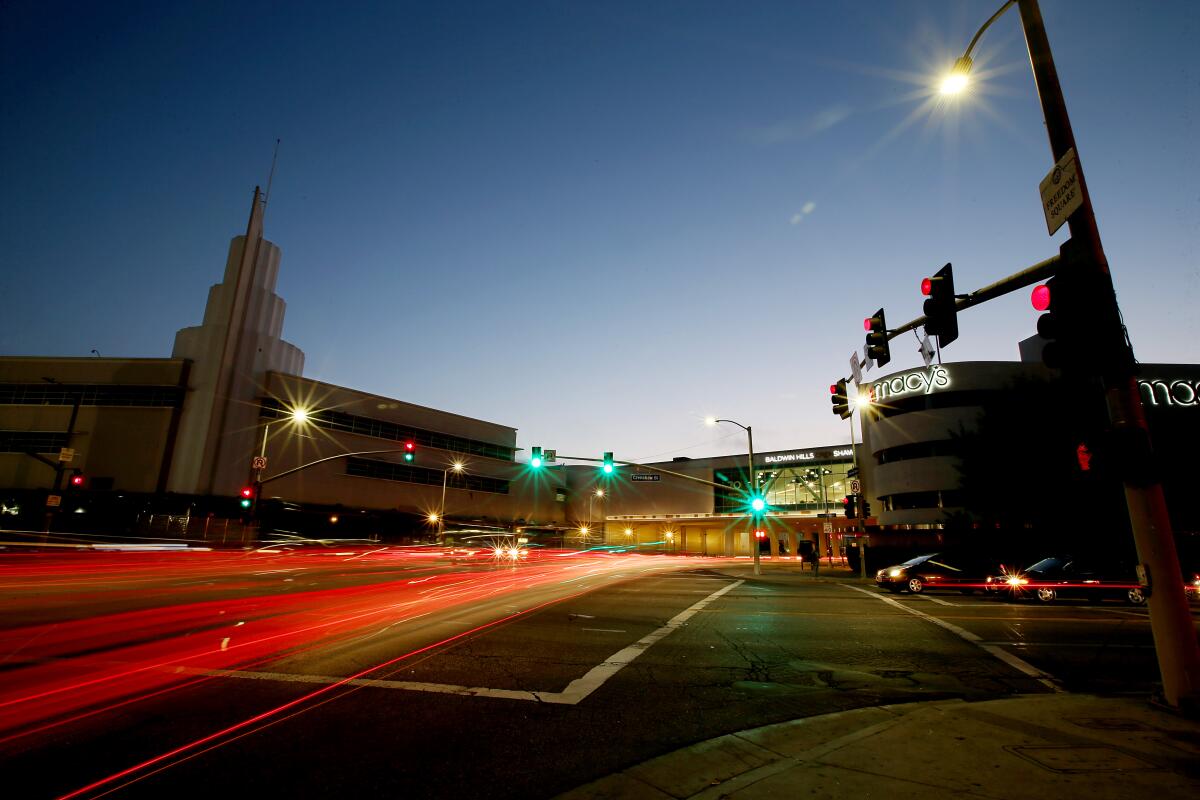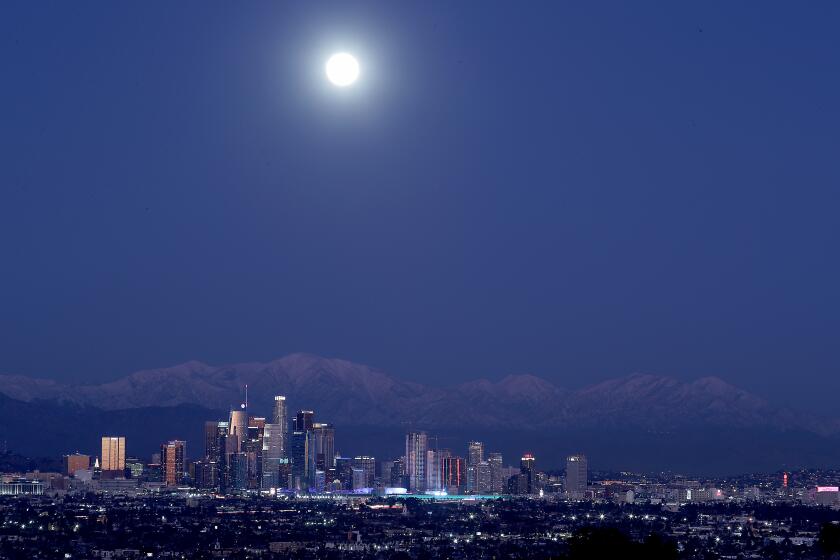Behind these names, you’ll find stories of L.A.’s Black history

- Share via
Oh, sure, now Los Angeles is a blue town, a liberal town, and one that rejoices in its diversity.
But it could’ve been a close call. Before the Civil War, half of L.A.’s Anglo residents were Southerners. In the 1860 presidential election here, Abraham Lincoln came in third. On the first Fourth of July of the war, someone hoisted the Confederate flag over the town’s central plaza. Three U.S. Army officers here resigned, left California and became Confederate generals; soon, members of a secret militia too had “gone to Dixie.” Had secession been put to a vote, Southern California would probably have joined the slave-holding Confederacy.
And to think that only 80 years before, Los Angeles was founded by 44 men, women and children who had been half-persuaded and half-prodded to come here from Mexico, and more than half of them had African ancestry.
So against that back story, this column for Black History Month, about new names for new times, launches with the life of an enslaved woman who in 1856 acquired a new life and a new name. She talked her way to freedom for herself and her family from a “master” who intended to drag them out of the free state of California to the slave state of Texas.
Bridget Mason, “Biddy,” born in the South in 1818, was a midwife and healer who shepherded Robert Smith’s vast household from Mississippi to Utah and in 1851 to San Bernardino. Free Black families who encountered her there may have clued her in about the legally free soil of California.
And in December 1855, the same free Black people may have tipped off the sheriff about the white man with 14 slaves hunkered down near Santa Monica Canyon, planning a getaway to Texas.
Around New Year’s Eve, sheriffs from two counties, along with some free Black men and their ranch hands, thundered down on Smith’s hideout with court writs and the force to back them up. Within two weeks, Biddy found herself in Judge Benjamin Hayes’ chambers, describing Smith’s duplicities — in chambers, because California law banned people of color from giving evidence openly against white people.
Hayes, like his L.A. townsmen, was a Southern sympathizer. His wife had owned slaves. But dura lex, sed lex — the law is hard, but it is the law — and the law in California forbade slavery. So boo-friggin’-hoo for Smith, who tried to fast-talk the court into believing that his slaves were really his “traveling companions.”
Biddy and her family were, Hayes ruled, “entitled to their freedom and are free forever.” (It took a civil war to make that come to pass for Black Americans in the South.)
The woman who had had no last name gave herself one: Mason. And with her earnings as a midwife and nurse, she parlayed $250 savings into a real estate empire that made her one of L.A.’s richest — and most generous-spirited — women. She died beloved and mourned, yet it took 97 years for a proper tombstone to mark her grave in the segregated section of Evergreen Cemetery. Her story is vividly told on 81 feet of panels in Biddy Mason Memorial Park in downtown L.A., the nucleus of her property empire.
Explaining L.A. With Patt Morrison
Los Angeles is a complex place. In this weekly feature, Patt Morrison is explaining how it works, its history and its culture.
A more visible memorial — because who can overlook freeways? — is Martin Luther King Jr. Boulevard, off the Harbor Freeway below Exposition Park. On MLK Day in 1983, its name was changed from Santa Barbara Avenue, which it had been for at least 70 years. And oh, the NIMBY chorus — “Not in my boulevard, you!”
The man who crusaded for the name change was Celes King III. He was a Tuskegee Airmen pilot who grew up at his family’s Dunbar Hotel, the “Waldorf-Astoria of Black America.” It was built as the Hotel Somerville, and it hosted the West’s first NAACP convention in 1928. It anchored the renowned music clubs of Central Avenue, and its guest book would fill with signatures of renown, like those of Thurgood Marshall and Billie Holiday. As a boy, Tom Bradley, the first Black mayor of modern-era L.A., hung around its entrance to spot the celebs.
Bradley never got the big-street treatment. Five years after Bradley died, a retiring councilman’s wish to rename part of fabled Crenshaw Boulevard for Bradley was DOA; “Crenshaw” was a name too vested in Black culture and history to change it. Instead, you can find Bradley’s name principally on the international terminal at LAX, and on his gravestone at Inglewood Cemetery.
Running parallel to MLK Boulevard is Jefferson Boulevard, and here’s the proof that all roads do lead to L.A. Frederick Madison Roberts, a great-grandson of the third president and his slave Sally Hemings, became the first Black member of the California Legislature, winning a mostly white Assembly district against a candidate whose campaign consisted of handing out cards reading, “My opponent is a n—.”
L.A. is a place like no other. You’ve got questions. Patt Morrison probably has answers and can definitely find out.
Jefferson, Washington and Adams Boulevards — L.A.’s “presidents row” of boulevards — were joined by Barack Obama Boulevard in 2019, when about 3½ miles of Rodeo Road in Baldwin Hills/Crenshaw were rechristened for the 44th president. The year before, so was a snippet of the 134 Freeway overlooking Obama’s two-year alma mater, Occidental College.
Some places were waaay overdue for renaming. We won’t publish the original name of a 2,031-foot peak between Malibu and Agoura, but you’ll get it when you hear that in 1964, its name was “cleaned up” to Negrohead Mountain. Finally, in 2009, the name that should have been there all along was bestowed on it: Ballard Mountain was at last named for John Ballard, a contemporary of Biddy Mason’s and another ex-slave and real estate whisperer. As a Black man of property, Ballard found himself nudged out of an increasingly valuable central L.A. to his homesteaded acres in the mountains. Even there, someone tried to burn him out.
In 1997, Fire Station No. 30, a shabby building on South Central Avenue, took a new name and identity: the African American Firefighter Museum. It was founded by Arnett Hartsfield Jr., a Black firefighter who served there when it was one of the city’s two segregated stations.
As the fire department was integrated in the 1950s, Hartsfield and his colleagues were dispersed to white stations where, “The captain met me at the door and gave me a direct order never to enter the kitchen when the white firemen were eating, to use my own pots and pans and to shower only when no whites were using the washroom.” And guess which firefighter got assigned to scrubbing the toilets?
In 2007, the city of L.A. got its first Black fire chief, and two years later, John Ballard’s mountain got its proper name. And Arnett Hartsfield had lived to see both.
More to Read
Sign up for Essential California
The most important California stories and recommendations in your inbox every morning.
You may occasionally receive promotional content from the Los Angeles Times.













